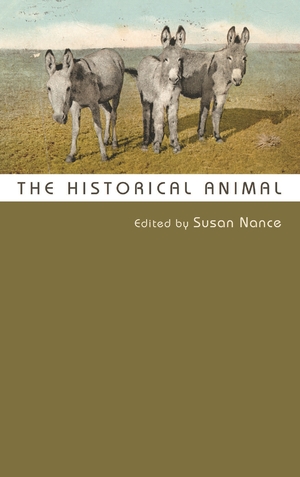"Coming at the non-human from multiple times, places, and
methodologies, The Historical Animal captures the vibrancy and
promise of history and animal studies. The collection spans the
globe and the centuries, bringing together essays on burros and
whales, zoos and city streets. Showing off the range and talent of
historians working on animals in the past from medieval England
to modern Chicago, The Historical Animal stands as the capstone
to a new and energetic school of inquiry."—Jon T. Coleman, author of Vicious: Wolves and Men in America,"One of the finest edited collections I
have encountered in animal history: fascinating,
readable, and accessible. It will
be appropriate to use with undergraduates
as well as graduate students."—Ann N. Greene, Department of History and Sociology of Science, University of Pennsylvania,"From Appalachian salamanders facing a reshaping landscape to the way the scarred bodies of orcas reshaped a generation’s thinking about how whales should be studied and perceived, the writings offer non-anthropocentric perspectives of how animals shape history in their own right and not merely as humanity’s partners or as objects of interest or scorn. Although presented as history, this work would also find relevance in courses in philosophy and environmental science."—Choice
"A useful addition to the growing materials in Animal Studies relating to history. This should prove to be an important book for those well versed in the study of animals’ pasts, as well as those new to the field. It certainly deserves to be in university libraries and on reading lists for both history and animal studies courses."—Anthrozoös Journal
"Showing the power of taking animals seriously in historical scholarship, The Historical Animal should be consulted not only by practitioners of animal history but also any historian interested in learning more about this exciting new subfield."—Journal of Social History
Description
The conventional history of animals could be more accurately described as the history of human ideas about animals. Only in the last few decades have scholars from a wide variety of disciplines attempted to document the lives of historical animals in ways that recognize their agency as sentient beings with complex intelligence. This collection advances the field further, inviting us to examine our recorded history through an animal-centric lens to discover how animals have altered the course of our collective past.
The seventeen scholars gathered here present case studies from the Pacific Ocean, Africa, Europe, and the Americas, involving species ranging from gorillas and horses to salamanders and orcas. Together they seek out new methodologies, questions, and stories that challenge accepted historical assumptions and structures.
Drawing upon environmental, social, and political history, the contributors employ research from such wide-ranging fields as philosophy and veterinary medicine, embracing a radical interdisciplinarity that is crucial to
understanding our nonhuman past. Grounded in the knowledge that there has never been a purely human time in world history, this collection asks and answers an incredibly urgent question for historians and others interested in the nonhuman past: in an age of mass extinctions, mass animal captivity, and climate change, when we know much of what animals have done in the past, which of our activities will we want to change in the future?
Table of Contents
Introduction, Susan Nance
PART ONE: Historicizing Nonhumans
1. Change in Black and White: Killer Whale Bodies and the New Pacific Northwest, Jason Colby
2. Beasts of Burden: Feral Burros and the American West, Abraham H. Gibson
3. Zombie Zoology: History and Reanimating Extinct Animals, Sandra Swart
PART TWO: Archives and the Animal Trace
4. Animal Archive Stories: Species Anxieties in the Mexican National Archive, Zeb Tortorici
5. Finding Animals in History: Veterinary Artifacts and the Use of Material History, Lisa Cox
6. Nonhuman Animal Testimonies: A Natural History in the First Person? Concepción Cortés Zulueta
PART THREE: The Animal Factor of Historical Causation
7. Horses and Actor-Networks: Manufacturing Travel in Later Medieval England, David Gary Shaw
8. Species Agency: A Comparative Study of Horse–Human Relationships in Chicago and Rural Illinois, Andria Pooley-Ebert
9. Too Sullen for Survival: Historicizing Gorilla Extinction, 1900–1930, Noah Cincinnati
10. Migrant Muskoxen and the Naturalization of National Identity in Scandanavia, Dolly Jørgensen
PART FOUR: Animals Coping with Adapting to Us
11. Exploring Early Human-Animal Encounters in the Galapagos Islands Using a Historical Zoology Approach, Nicola Foote and Charles W. Gunnels IV
12. Of Leopards and Lesser Animals: Trials and Tribulations of the “Human-Leopard Murders” in Colonial Africa, Stephanie Zehnle
13. Mountain Meeting Ground: History at an Intersection of Species, Drew A. Swanson
PART FIVE: Documenting Interspecific Partnerships
14. Viewing the Anthrozootic City: Humans, Domesticated Animals, and the Making of Early Nineteenth-Century New York, Scott A. Miltenberger
15. “He Took Care of Me”: The Human-Animal Bond in Canada’s Great War, Andrew McEwen
16. Tony the Wonder Horse: A Star Study, Courtney E. White
Notes
Works Cited
Contributors
Index
About the Author
Susan Nance is an associate professor in the Department of History and an affiliated faculty member at the Campbell Centre for the Study of Animal Welfare at the University of Guelph, Ontario, Canada. She is the author of Entertaining Elephants: Animal Agency and the Business of the American Circus.
6 x 9, 432 pages, 13 black and white illustrations
September 2015

